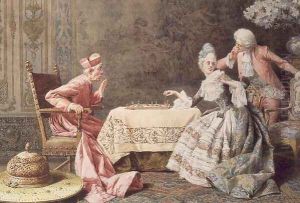R. Raimondi Paintings
Marcantonio Raimondi, often referred to as R. Raimondi, was an Italian engraver, famed for being one of the most significant printmakers of the Renaissance period. Born in 1480 in Argini, near Bologna, he initially trained in the workshop of the eminent goldsmith and painter Francesco Raibolini, known as Francia. His early works reflect the fine craftsmanship and attention to detail characteristic of a goldsmith's discipline.
Raimondi's journey into printmaking was deeply influenced by the works of Albrecht Dürer, whom he encountered either through Dürer's own prints or possibly during a trip to Northern Italy where Dürer's works were well known. Raimondi's admiration for Dürer's art is evident in his early adoption of Dürer's style and techniques, which eventually led to a controversy when Raimondi directly copied some of Dürer's works. This incident is among the first known cases of copyright dispute in art history, where Dürer complained to the Venetian government about Raimondi's copies, leading to a brief imprisonment for Raimondi.
Despite this setback, Raimondi's career flourished after he moved to Rome, probably around 1510. There, he was introduced to the circle of Raphael, one of the leading artists of the High Renaissance. Under Raphael's guidance, Raimondi's work took on new dimensions; he translated Raphael's and his pupils' drawings into prints, making Raphael's designs accessible to a much wider audience and contributing to the dissemination of the High Renaissance style throughout Europe. His engravings after Raphael's works, such as 'The Judgment of Paris' and 'The Massacre of the Innocents', are considered masterpieces of engraving for their complexity and fidelity to Raphael's compositions.
Throughout his career, Raimondi continued to refine his technique, becoming a master in the use of the burin, a tool used for engraving on metal plates. His prints are characterized by their clear, clean lines and delicate rendering of details, which were highly influential in the development of the Italian engraving tradition.
Marcantonio Raimondi's legacy is marked not only by his own works but also by his role in founding a school of engravers in Rome, which propagated his techniques and style. His influence extended to future generations of printmakers, who continued to reproduce and adapt compositions from the leading artists of their time.
Raimondi's date of death is not precisely known, with estimates ranging from 1534 to 1540. Despite this uncertainty, his contributions to the art of engraving remain undisputed, solidifying his reputation as one of the foremost printmakers of the Renaissance.
